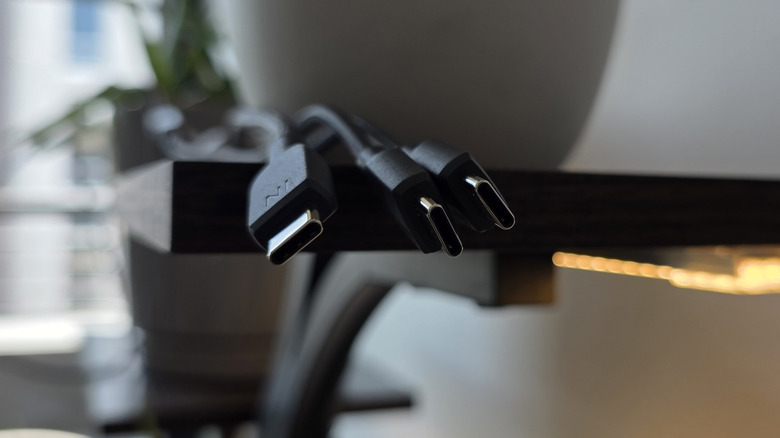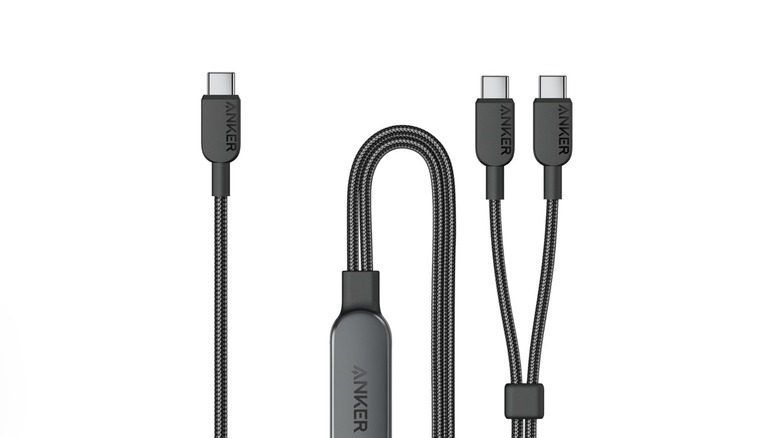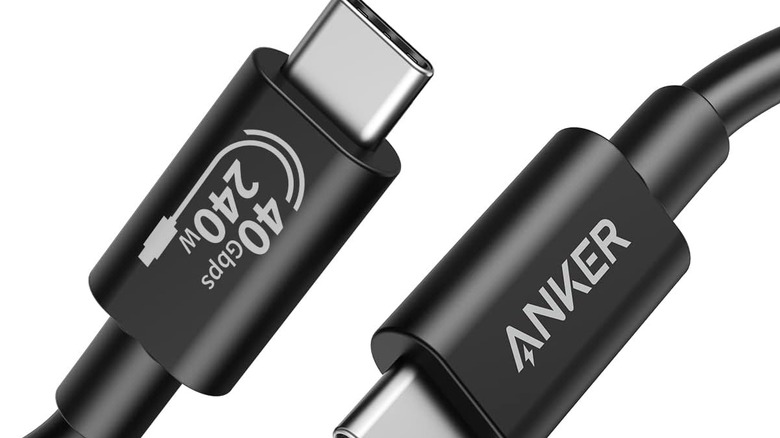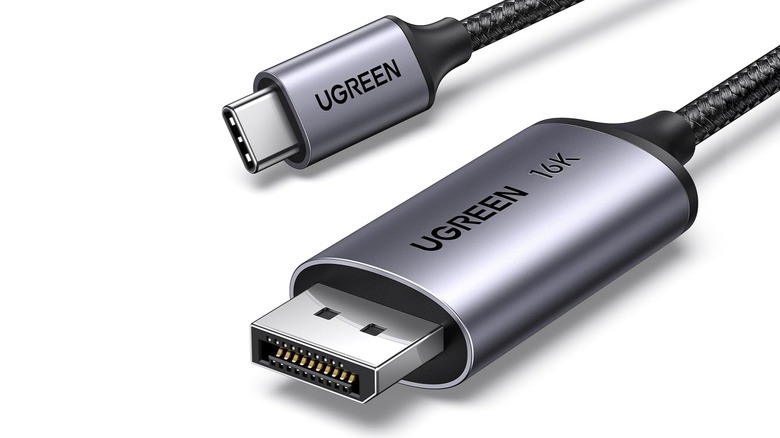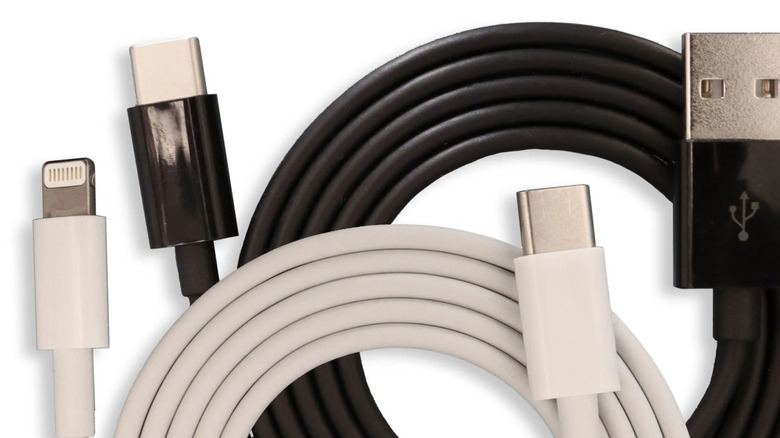5 USB-C Cables That Do More Than Charge Your Phone
We may receive a commission on purchases made from links.
We've finally reached the point where it's rare to find a device without a USB-C port. Laptops, tablets, and smartphones all feature at least one. Even the iPhone finally got a USB-C glow-up a couple of years back, meaning you can now borrow a friend's charging cable without worrying about the connector. But while charging is a major benefit of USB-C, it's also capable of much more. USB-C can transfer data, facilitate video output, and connect to protocols like Ethernet for wired networking. All you need are the right cables.
We've rounded up five cables that can level up your USB-C game by adding extra functionality or convenience to your tech setup beyond basic charging. From supercharged file transfers and internet speeds to better video connectivity and even diabolically disguised hacking tools, these clever cords can do it all. And yes, some of them also charge your phone, but with added functionality you're not getting from the cable that came in the box. I've tested all of these cables myself, with one notable exception (you'll quickly understand why), to put them through their paces and integrate them into my tech life. So, here are five USB-C cables that do more than charge your phone.
This Anker 2-in-1 USB-C cable charges two gadgets at once
A cable that's as simple as it is convenient, the Anker 2-in-1 USB-C cable is a product I bought the moment I laid eyes on it. This hydra-headed cable does more than charge your phone: it charges two of them! With one USB-C connector on one end of the cable and two on the other side, you can juice up two devices at the same time. If you've ever found yourself hot-swapping a single cable between your phone and laptop or tablet, this is a cheap way to put those frustrations behind you.
You won't get the full charging speed from your power source with this cable, as it has to split the power, so prepare accordingly. For example, if you connect a standard iPhone charging brick to two iPhones with this cable, they'll each charge at about half the speed. It's best to pair this cable with a high-powered charging brick to ensure that you aren't replacing one charging-related headache with another. However, it will generally prioritize power to whichever device is connected to it first.
Anker's 2-in-1 cable includes a cable slider to prevent the other connector from dangling awkwardly if you're only charging one device. It feels sturdy, with a braided exterior and plenty of reinforcement around the connector heads. It quickly found a place in my work bag, providing an easy way to charge my phone and laptop (or tablet) while I'm working from my favorite coffee shop.
A USB4 240W 80Gbps cable will give you future-proof speeds
A cable you'll need to make sure you're prepared for the future is a USB4 Version 2.0 cable. These are the only cables that can take full advantage of the fastest USB port type available as of this writing, supporting a staggering 80Gbps of data transfer speed and 240W of power delivery. Any cable with these specs will do, but my personal choice is this Anker USB4 40Gbps 240W USB-C cable.
You may be wondering why we're linking a cable advertised for 40Gbps when discussing 80Gbps speeds. The answer is that the USB-IF (the group responsible for developing and maintaining USB) has announced that any USB4 40Gbps cable will be capable of hitting 80Gbps speeds when connected to USB4 Version 2.0 devices. Since there aren't many 80Gbps devices on the consumer market yet, I haven't had a chance to test it.
The major benefit of a cutting-edge USB-C cable is that you won't need to upgrade it for a long, long while. 80Gbps is frankly overkill, able to transfer 10 gigabytes of data per second. That means transferring an entire 4K movie in less time than it takes to say "One Mississippi." The 240W charging speeds also mean you'll be able to charge some of the most powerful laptops with ease.
UGreen USB-C to DisplayPort 2.1 or LAN cable
Among the best hidden capabilities of USB-C are its alt modes for HDMI and DisplayPort, which can carry video signals. Many devices with USB-C ports, including most smartphones and many laptops, support video output over USB-C, a feature infrequently communicated to the user. Of course, outside of the few monitors that take video input from USB-C, you'll need a way of converting from Type-C to DisplayPort or HDMI. You could get a dongle, but why add extra steps when a single cable will get the job done?
I've been using the UGREEN USB-C to DisplayPort 2.1 dongle to connect my Windows laptop and Android tablet to my gaming monitor. The company also makes an HDMI variant, but DisplayPort has an advantage in that it supports variable refresh rate technologies like NVIDIA G-Sync and AMD FreeSync for better visual stability. Unless your display only supports HDMI, the DisplayPort version is more robust.
Your device's USB-C port may also be capable of accepting a wired internet connection, in which case you can pick up a USB-C to LAN cable like this Cable Matters USB-C to Ethernet Cable, which I use when taking my gaming laptop on the go. Whether you need a more stable Internet connection for online gaming or need to upload and download large files more quickly, the ability to connect your USB-C directly to a network can be very useful.
The Hak5 O.MG Cable can teach you about hacking
We covered the Hak5 O.MG Cable a few months ago when discussing how USB-C cables can hide malicious hardware. Developed for use by cybersecurity researchers, educators, and experts, this cable ingeniously hides a bunch of tech inside a normal-looking USB-C cable and can carry out attacks against the host device once connected. It's the one cable on this list I haven't personally tested, both because it's quite expensive and I don't have a great use for it.
The O.MG Cable is best at carrying out keystroke injection attacks that can run preprogrammed scripts on the host device. This is one of the most common forms of direct-access attack, and it's one of the reasons you should avoid buying used USB flash drives. Obviously, the O.MG Cable could prove useful for malicious actors, but you can use it to teach yourself about cybersecurity, or even run custom scripts on your devices.
The creators of this cable even managed to squeeze a Wi-Fi radio inside, allowing users to control it via a web app. You can save, load, and run scripts remotely, allowing the cable to remain dormant until the payload is activated. Moreover, it can also act as a keylogger when a keyboard is plugged into the other end, collecting everything the user types. Even if you don't see a need for the OM.G cable in your life, its mere existence is a potent reminder that even the most commonplace gadgets can be dangerous, and that you should exercise caution before plugging something into your devices.
The Soopii 100W cable displays your charging speed
The Soopii 100W USB-C to USB-C cable has a small LED display that tells you how many watts it's pushing to your device while charging. This is no mere party trick — it's often difficult to know how fast your smartphone or tablet is charging because it won't tell you the exact speed. You may think your device is charging at its fastest because you're using a fast charger, but that's not necessarily the case. There could be several issues that cause fast charging to not work, including problems with the wall plug, charging brick, or your device. Moreover, many phones actually won't charge at their maximum speed unless connected to a charger rated for a higher wattage.
Depending on your smartphone, you could use an Android app like AccuBattery to see your charging speeds, but that requires letting it run in the background, and I find that apps relying on your device's internal readings can be inaccurate. With a cable that displays its wattage, I get a more objective reading at the point of transfer. However, you should treat this cable as a diagnostic tool. Testing from PCWorld indicates that while the wattage readout on the Soopii cable is accurate, it falls short for data transfers. That said, slow charging may not always be a cause for concern. Fast charging can be hard on a lithium-ion battery, and modern smartphones study your usage patterns to smartly determine when they can reduce charging speeds.
